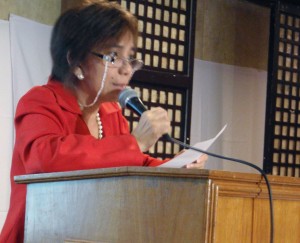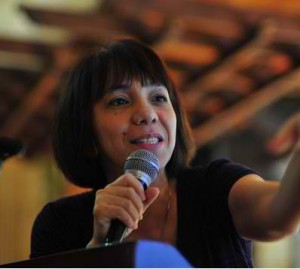By YVONNE T. CHUA
 ROY Mendoza remembers Feb. 14, 2005 only too well.
ROY Mendoza remembers Feb. 14, 2005 only too well.
He and his wife had to scrap plans of celebrating Valentine’s Day after her boss asked her to work overtime to pore over documents stored in nine boxes.
There would be other Valentine’s Days, the boss explained, and the work at hand was truly urgent.
The boss was then Ombudsman Simeon Marcelo. The nine boxes contained records of transactions by former military comptroller Maj. Gen. Carlos Garcia who was being investigated for plunder. And the wife is Heidi Mendoza, then a state auditor who has shot to prominence after she testified in Congress recently that the investigation she undertook under Marcelo’s watch back then had yielded a strong case against the now retired general.
“When she works, it’s as if she has no husband,” Roy, speaking in Filipino, on Monday told a forum at Club Filipino organized by good governance advocates who marked Valentine’s Day with his celebrated wife.
But it is with pride, not recrimination, that Roy, a professor of history at the Ateneo de Manila Univerity, spoke of his wife’s dedication to public service, even in “lonely battles” like the Garcia plunder case. “She gives everything she has and can’t and won’t rest until she’s finished her job,” he said.
His compliment did not go unreturned.
At the forum where she urged people to “stand firm” in the crusade for a good government and launched the website for truthtellers like her (www.ihearttruthtellers.org), Heidi said she draws her strength from her husband and described their union as one “hatched in deep love for country.”
Clad in red blouse, white slacks and red wedge shoes in keeping with the spirit of Valentine’s Day, Heidi unabashedly shared with the audience her love story that explains why she firmly believes it possible to combine love for family, love for God and love for country.
Waxing nostalgic—and romantic, Heidi said she first met her husband in December 1980 in Quezon province when he decided to “go to the mountains,” ready to leave his family and work to end the repressive regime of then dictator Ferdinand Marcos.
He was long-haired, bearded and “mukhang poor at makalupa (looked poor and unrefined),” she recalled. She, on other other hand, was a “Sanrio kid,” who wore Sanrio pins and ribbons, liked ice cream and was “sosy (upscale).”
But Heidi found herself drawn to the man who had introduced himself as “Mon Dimaya.” (She would learn that his real name is Roy Mendoza only in 1986, when they were about to get married.)
She would call him when she visited Manila, and later embraced his cause. She worked in poor communities where—to her parents’ shock—she learned to clean houses and cook.
She recalled her first attempt at cooking tinola: She poured vinegar instead of kerosene to fire the stove and forgot to throw in an important ingredient in the chicken dish: papaya.
It was after the EDSA Revolution in 1986 that Heidi got a call from Roy. He said he needed to see her urgently and traveled to Mindoro where she was at the time. They would not meet in Mindoro, but in Manila.
This time, Roy looked different. He wore formal clothes and, in a serious voice, said that now that the dictator had been overthrown and democracy restored—“Malaya na ang bayan (The country is free)”—he could finally propose marriage.
Roy and Heidi were, however, unlike most couples. They do not publicly display their affection for each other, not even to their three children, making the latter wonder if they were in love with each other. While other married couples called each other “Sweety,” “Honey” or other terms of endearment, Roy and Heidi called each other “Bok,” the Filipino slang for “pal” or “friend.”
On Valentine’s Day, Roy would not give Heidi chocolates or roses, and when she complained, would gift her with a card filled with illustrations of roses because, he told her, “these don’t wilt.”
There were times when Heidi said she “hated” Roy for giving money to others when their family needed it as much. Like one Christmas when he donated his bonus to the slum community in Parola, Tondo, so the residents could pay their electricity bill. Roy was then working with the Presidential Commission on Urban Poor.
But Heidi, who was reared on prayers and the rosary, said it was their love for each other that transcended everything. “It is his love that carried me through the most difficult and challenging times of my life,” she said.
After she resigned from the Commission on Audit in 2006 over what she was the lack of support for her investigation on Garcia, Heidi would spend weekends with civil society organizations involved in governance work as part of her outreach.
Roy was supportive, especially when Heidi decided she still wanted to testify against Garcia even after she was no longer in government. He would accompany her to the trial at the Sandiganbayan. “We were alone most of the time, and she had to be absent on some days,” he said.
He recalled how Heidi cried when Garcia warned her after one hearing that “there will be a day of recokining.”
Then came the plea bargain agreement between Garcia and government prosecutors. “She tossed and turned in bed,” he said, explaining that Heidi was restless that she later resolved to quit her job at a multilateral funding agency and launch her “truthtelling” mission.
The Mendozas did not expect how rapid the developments would be that would put Heidi in the limelight as expressions of support for her crusade snowballed.
“She just wanted to explain the case,” he said. Heidi was originally reluctant to appear before Congress, fearing this would expose her and her family to risks.
But there is no turning back for the couple who see the establishment of a “truthworthy and honest government” as the ultimate goal of their mission. And the path, Heidi said, is through “constructive engagement between citizens and government.”
She acknowledges that the crusade for good government will not be won in a day.
But, in the same breath, she said the crusade will succeed as long as all the actions toward this goal are rooted in “faith, hope and love.” And she said she has “boundless faith and hope” that the Filipinos can do it.
